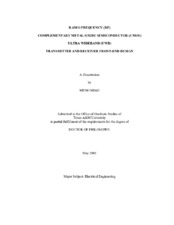| dc.description.abstract | The low-cost low-power complementary metal-oxide semiconductor (CMOS)
ultra wideband (UWB) transmitter and receiver front-ends based on impulse technology
were developed. The CMOS UWB pulse generator with frequency-band tuning
capability was developed, which can generate both impulse and monocycle pulse signals
with variable pulse durations. The pulse generator integrates a tuning delay circuit, a
square-wave generator, an impulse-forming circuit, and a pulse-shaping circuit in a
single chip. When integrated with the binary phase shift keying (BPSK) modulator, the
transmitter front-end can generate a positive impulse with 0.8 V, negative impulse with
0.7 V, as well as the positive/negative monocycle pulse with 0.6 – 0.8 V, all with tunable
pulse durations.
The UWB receiver front-end including the template pulse generator, low noise
amplifier (LNA), and multiplier was developed. The cascoded common-source
inductively degenerated LNA, with extended ultra-wideband ladder matching network,
as well as shunt-peaking topology, was selected to form the impulse-type UWB LNA.
The structure-optimized and patterned ground shield (PGS) inductors were also studied
and used in LNA design to improve the LNA performance. The maximum gain of 12.4
dB was achieved over the band. For the 3-dB bandwidth, 2.6 – 9.8 GHz was achieved.
The average noise figure of 5.8 dB was achieved over the entire UWB band of 3.1-10.6
GHz. The UWB multiplier based on the transconductor multiplier structure was investigated, with the shunt-peaking topology applied to achieve the pole-zero
cancellation and extend the multiplier bandwidth from 2 GHz to 10 GHz.
A low-cost, compact, easy-to-manufacture coplanar UWB antenna was
developed that is omni-directional, radiation-efficient and has a stable UWB response. It
covers the entire UWB frequency range of 3.1 – 10.6 GHz, with the return loss better
than 18-dB. This novel uniplanar antenna was integrated with the developed CMOS
tunable pulse generator to form the UWB transmitter front-end module. This UWB
module can transmit the monocycle pulses and the signals having shape similar to the
first derivative of the monocycle pulses, all with the tunable pulse durations. The
proposed UWB front-ends have the potential application in short-range communication,
GPR, and short-range detections. | en |


